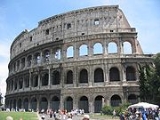
List of ancient monuments in Rome
Encyclopedia
This is a list of ancient monuments from republican
and imperial
periods in the city of Rome
, Italy
.
Amphitheatre

Baths
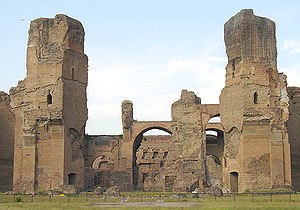
Circuses
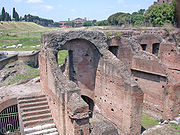
Gardens
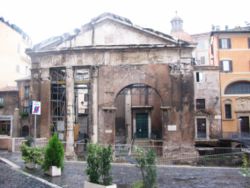
Theatres

Basilica

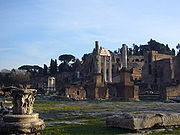
Fora venalia
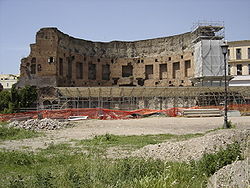
Aqueducts
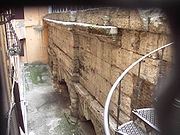
Bridges

Cemeteries
Roads
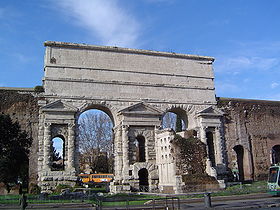
Triumphal arch

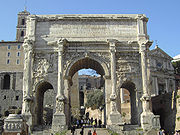
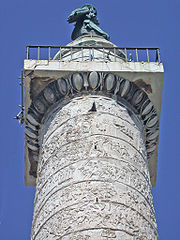
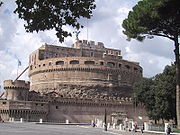

Aventine Hill
Capitoline Hill
Campus Martius

Esquiline Hill
Forum Boarium

Forum Holitorium
Palatine Hill
Quirinal Hill
Roman Republic
The Roman Republic was the period of the ancient Roman civilization where the government operated as a republic. It began with the overthrow of the Roman monarchy, traditionally dated around 508 BC, and its replacement by a government headed by two consuls, elected annually by the citizens and...
and imperial
Roman Empire
The Roman Empire was the post-Republican period of the ancient Roman civilization, characterised by an autocratic form of government and large territorial holdings in Europe and around the Mediterranean....
periods in the city of Rome
Rome
Rome is the capital of Italy and the country's largest and most populated city and comune, with over 2.7 million residents in . The city is located in the central-western portion of the Italian Peninsula, on the Tiber River within the Lazio region of Italy.Rome's history spans two and a half...
, Italy
Italy
Italy , officially the Italian Republic languages]] under the European Charter for Regional or Minority Languages. In each of these, Italy's official name is as follows:;;;;;;;;), is a unitary parliamentary republic in South-Central Europe. To the north it borders France, Switzerland, Austria and...
.
AmphitheatreAmphitheatreAn amphitheatre is an open-air venue used for entertainment and performances.There are two similar, but distinct, types of structure for which the word "amphitheatre" is used: Ancient Roman amphitheatres were large central performance spaces surrounded by ascending seating, and were commonly used...
s

- Amphitheatre of Caligula
- Amphitheatrum CastrenseAmphitheatrum CastrenseThe Amphitheatrum Castrense is a Roman amphitheatre in Rome, next to the church of Santa Croce in Gerusalemme. It is the second ancient amphitheatre of Rome after the Colosseum.-History:...
- ColosseumColosseumThe Colosseum, or the Coliseum, originally the Flavian Amphitheatre , is an elliptical amphitheatre in the centre of the city of Rome, Italy, the largest ever built in the Roman Empire...
- Amphitheatre of Nero
- Amphitheater of Statilius TaurusAmphitheater of Statilius TaurusThe Amphitheatre of Statilius Taurus was an amphitheatre in ancient Rome.The amphitheatre was built in 29 BC. Earlier arenas were temporary structures that were disassembled after the event. The amphitheatre was built by Titus Statilius Taurus, who paid for it from his own resources...
BathsThermaeIn ancient Rome, thermae and balnea were facilities for bathing...

- Baths of AgrippaBaths of AgrippaThe Baths of Agrippa were a structure of ancient Rome, built by Marcus Vipsanius Agrippa, the first of the great thermae constructed in the city. In their first form, constructed at the same time as the Pantheon and on axis with it, as a balaneion , they were apparently a hot-air bath with a cold...
- Baths of CaracallaBaths of CaracallaThe Baths of Caracalla in Rome, Italy were Roman public baths, or thermae, built in Rome between AD 212 and 216, during the reign of the Emperor Caracalla.- History :...
- Baths of Commodus
- Baths of ConstantineBaths of Constantine (Rome)Baths of Constantine was a public bathing complex built on the Quirinal Hill in Rome by Constantine I, probably before 315.-Construction and plan:...
- Baths of Decius
- Baths of DiocletianBaths of DiocletianThe Baths of Diocletian in Rome were the grandest of the public baths, or thermae built by successive emperors. Diocletian's Baths, dedicated in 306, were the largest and most sumptuous of the imperial baths. The baths were built between the years 298 AD and 306 AD...
- Baths of Domitian
- Baths of Licinius SuraBaths of Licinius SuraThe Baths of Licinius Sura were an ancient Roman bath complex built by Lucius Licinius Sura on the Aventine Hill in Rome.It was restored during the short reign of Gordian III. The baths were damaged during the 410 sack of Rome by Alaric I, and again restored in 414...
- Baths of Nero and Alexander
- Baths of Septimius Severus
- Baths of TitusBaths of TitusThe Baths of Titus were public baths built in Rome in 81 by Emperor Titus.The baths sat in the base of the Esquiline hill, an area of parkland and luxury estates which had been taken over by Nero for his Golden House or Domus Aurea...
- Baths of TrajanBaths of TrajanThe Baths of Trajan were a massive thermae, a bathing and leisure complex, built in ancient Rome starting from 104 AD and dedicated during the Kalends of July in 109...
CircusesCircus (building)The Roman circus was a large open-air venue used for public events in the ancient Roman Empire. The circuses were similar to the ancient Greek hippodromes, although serving varying purposes. Along with theatres and amphitheatres, Circuses were one of the main entertainment sites of the time...

- Circus FlaminiusCircus FlaminiusThe Circus Flaminius was a large, circular area of land in Rome that contained a small race-track reserved for mysterious games, and various other buildings and monuments. It was located in the southern end of the Campus Martius, near the Tiber River. It was ‘built,’ or sectioned off, by Flaminius...
- Circus MaximusCircus MaximusThe Circus Maximus is an ancient Roman chariot racing stadium and mass entertainment venue located in Rome, Italy. Situated in the valley between the Aventine and Palatine hills, it was the first and largest stadium in ancient Rome and its later Empire...
- Circus of MaxentiusCircus of MaxentiusThe Circus of Maxentius is an ancient structure in Rome, Italy; it is part of a complex of buildings erected by emperor Maxentius on the Via Appia between AD 306 and 312...
- Circus of NeroCircus of NeroThe Circus of Nero or Circus of Caligula was a circus in ancient Rome.-Construction:It was begun by Caligula on the property of his mother Agrippina on the Ager Vaticanus , and finished by Nero...
- Circus Varianus
GardensRoman gardensRoman gardens and ornamental horticulture became highly developed during the history of Roman civilization. The Gardens of Lucullus on the Pincian Hill at the edge of Rome introduced the Persian garden to Europe, around 60 BC...
- Horti Aciliorum
- Horti Agrippinae
- Horti Caesaris
- Horti Domitiae
- Horti LamianiHorti LamianiThe Lamian Gardens were a set of gardens located on the top of the Esquiline Hill in Rome, in the area around the present Piazza Vittorio Emanuele...
- Horti LicinianiHorti LicinianiThe Horti Liciniani were a set of gardens in ancient Rome, originally belonging to the gens Licinia, and which in the third century were owned by the Emperor Gallienus, himself a member of the gens...
- Horti Lolliani
- Gardens of LucullusGardens of LucullusThe Gardens of Lucullus were the setting for an ancient patrician villa on the Pincian Hill on the edge of Rome; they were laid out by Lucius Licinius Lucullus about 60 BCE...
- Gardens of MaecenasGardens of MaecenasThe Gardens of Maecenas, built by the Augustan era patron of the arts Gaius Maecenas, were the first gardens in the Hellenistic-Persian garden style in Rome...
- Horti Pompeiani
- Gardens of SallustGardens of SallustThe Gardens of Sallust were Roman gardens developed by the Roman historian Sallust in the 1st century BC. The landscaped pleasure gardens occupied a large area in the northwestern sector of Rome, in what would become Region VI, between the Pincian and Quirinal hills, near the Via Salaria and later...
- Horti TaurianiHorti TaurianiThe Horti Tauriani was a large set of gardens in ancient Rome around the residence of Statilius Taurus, eminent character of the 1st century. They were perhaps the cause of his conviction for magic, which allowed Agrippina to confiscate them and add them to the imperial estates...
Porticoes

- Porticus Aemilia
- Porticus Deorum Consentium
- Porticus of Livia
- Porticus OctaviaPorticus OctaviaThe Porticus Octavia was a portico in ancient Rome, built by Gnaeus Octavius in 168 BC to commemorate a naval victory over Perseus of Macedonia. It stood between the theatre of Pompey and the circus Flaminius...
- Porticus OctaviaePorticus OctaviaeThe Porticus Octaviae is an ancient structure in Rome.Built by Augustus in the name of his sister, Octavia Minor, at some time after 27 BC, in place of the Porticus Metelli, the porticus enclosed within its colonnaded walks the temples of Jupiter Stator and Juno Regina, next to the Theater of...
- Porticus Vipsania
TheatresRoman theatre (structure)The characteristics of Roman to those of the earlier Greek theatres due in large part to its influence on the Roman triumvir Gnaeus Pompeius Magnus. Much of the architectural influence on the Romans came from the Greeks, and theatre structural design was no different from other buildings...

- Theatre of BalbusTheatre of BalbusTheatre of Balbus was an ancient Roman structure in the Campus Martius of Rome. It was built in 13 BC by proconsul Lucius Cornelius Balbus , likely from the spoils of a military campaign by order of Augustus .Very little is mentioned of the theatre in ancient writings...
- Theatre of MarcellusTheatre of MarcellusThe Theatre of Marcellus is an ancient open-air theatre in Rome, Italy, built in the closing years of the Roman Republic. At the theatre, locals and visitors alike were able to watch performances of drama and song. Today its ancient edifice in the rione of Sant'Angelo, Rome, once again provides...
- Theatre of PompeyTheatre of PompeyThe Theatre of Pompey was a structure in Ancient Rome built during the later part of the Roman Republican era. It was completed in seven years, starting from 55 BC, and was dedicated early in 52 BC before the structure was fully completed...
Other
- Ludus MagnusLudus MagnusThe Ludus Magnus or The Great Gladiatorial Training School is the largest of the gladiatorial arenas in Rome, Italy. It was built by the emperor Domitian in the valley between the Esquiline and the Caelian hills, an area already occupied by Republican and Augustan structures...
- Odeum of Domitian
- Saepta JuliaSaepta JuliaThe Saepta Julia was a building in Ancient Rome where citizens gathered to cast votes. The building was conceived by Julius Caesar and dedicated by Marcus Vipsanius Agrippa in 26 BC. The building was originally built as a place for the comitia tributa to gather to cast votes . It replaced an older...
- Septizodium
- Stadium of DomitianStadium of DomitianThe Stadium of Domitian , also known as the Circus Agonalis, was located to the north of the Campus Martius in Rome, Italy. The Stadium was commissioned around 80 AD by the Emperor Titus Flavius Domitianus as a gift to the people of Rome, and was used mostly for athletic contests.- Construction and...
BasilicaBasilicaThe Latin word basilica , was originally used to describe a Roman public building, usually located in the forum of a Roman town. Public basilicas began to appear in Hellenistic cities in the 2nd century BC.The term was also applied to buildings used for religious purposes...
s

- Basilica AemiliaBasilica AemiliaThe Basilica Aemilia was a civil basilica in the Roman forum, in Rome, Italy. Today only the plan and some rebuilt elements can be seen. The Basilica was 100 meters long and about 30 meters wide...
- Basilica Argentaria
- Basilica FulviaBasilica FulviaThe Basilica Fulvia was a basilica built in ancient Rome. According to Livy , the censors M. Aemilius Lepidus and M. Fulvius Nobilior had it built in 179 BC. It may be that there had been a previous building existing on the site from 210 BC which was incorporated . In 78 BC, the consul M...
- Basilica JuliaBasilica JuliaThe Basilica Julia , is a structure that once stood in the Roman Forum. It was a large, ornate, public building used for meetings and other official business during the early Roman Empire. Its ruins have been excavated...
- Basilica of Junius BassusBasilica of Junius BassusThe Basilica of Junius Bassus was a civil basilica on the Esquiline Hill in Rome, on a site now occupied by the Seminario Pontificio di Studi Orientali, in via Napoleone III, 3. It is best known for its examples of opus sectile work.-History:It was built by Junius Annius Bassus in 331 during his...
- Basilica of MaxentiusBasilica of MaxentiusThe Basilica of Maxentius and Constantine is an ancient building in the Roman Forum, Rome, Italy...
- Basilica of Neptune
- Basilica Opimia
- Basilica Porcia
- Basilica Sempronia
- Basilica UlpiaBasilica ulpiaThe Basilica Ulpia was an ancient Roman civic building located in the Forum of Trajan. The Basilica Ulpia separates the temple from the main courtyard in the Forum of Trajan with the Trajan's Column to the northwest...
Forum Romanum

Imperial fora
- Forum of AugustusForum of AugustusThe Forum of Augustus is one of the Imperial forums of Rome, Italy, built by Augustus. It includes the Temple of Mars Ultor.-History:The triumvir Octavian vowed to build a temple honoring Mars, the Roman God of War, during the battle of Philippi in 42 BC...
- Forum of CaesarForum of CaesarThe Forum of Caesar, also known as Forum Iulium or Forum Julium, Forum Caesaris, is a forum built by Julius Caesar near the Forum Romanum in Rome in 46 BC.-Construction:...
- Forum of Nerva
- Forum of PeaceSanti Cosma e DamianoThe basilica of Santi Cosma e Damiano is a church in Rome, Italy, located in the Roman Forum. It is one of the ancient churches called tituli, of which cardinals are patrons as deacons: the Cardinal Deacon of the Titulus Ss. Cosmae et Damiani is Giovanni Cheli...
- Trajan's ForumTrajan's ForumTrajan's Forum is an ancient structure in Rome, Italy, chronologically the last of the Imperial fora. The forum was constructed by the architect Apollodorus of Damascus.-History:...
Fora venaliaForum VenaliumA Forum Venalium was a food market in Ancient Rome during the Roman Republic and Roman Empire. These mercantile forums were extensions of the Roman Forum and contained numerous buildings and monuments erected under the Republic and the Empire.In Politics Aristotle proposed that a city should have...
- Forum BoariumForum BoariumThe Forum Boarium was the cattle forum venalium of Ancient Rome and the oldest forum that Rome possessed. It was located on a level piece of land near the Tiber between the Capitoline, the Palatine and Aventine hills. Here, too, is where the first bridges were built...
- Forum HolitoriumForum HolitoriumThe Forum Holitorium was the market for vegetables, herbs and oil forum venalium of early ancient Rome, by the Tiber at the foot of the Capitoline and Palatine hills...
- Forum PiscariumForum PiscariumThe Forum Piscarium was the fish forum venalium of ancient Rome, north of the Roman Forum, between the Sacra Via and the Argiletum. It was burned in 210 BC and rebuilt the next year. In 179 it was incorporated in the general Macellum, built by Marcus Fulvius Nobilior in the same region.This forum...
- Forum Pistorium
- Forum SuariumForum SuariumThe Forum Suarium was the pork forum venalium of early Ancient Rome during the empire, mentioned first in two inscriptions of about 200 AD. This market was near the barracks of the cohortes urbanae in the northern part of the campus Martius, probably close to the present Via di Propaganda, and its...
- Forum VinariumForum VinariumThe Forum Vinarium was the wine forum venalium of early Ancient Rome, it was located in the area now of the quartiere Testaccio, between Aventine Hill and the Tiber....
Palaces

- Domus AureaDomus AureaThe Domus Aurea was a large landscaped portico villa, designed to take advantage of artificially created landscapes built in the heart of Ancient Rome by the Emperor Nero after the Great Fire of Rome had cleared away the aristocratic dwellings on the slopes of the Palatine...
- Flavian PalaceFlavian PalaceThe Flavian Palace, also known as Domus Flavia, is a part of the vast residential complex of the Roman Emperors on the Palatine Hill in Rome...
- Palace of Augustus
- Palace of Tiberius
AqueductsRoman aqueductThe Romans constructed numerous aqueducts to serve any large city in their empire, as well as many small towns and industrial sites. The city of Rome had the largest concentration of aqueducts, with water being supplied by eleven aqueducts constructed over a period of about 500 years...

- Anio NovusAnio NovusAnio Novus is an aqueduct of Rome. Together with the Aqua Claudia, it was begun by emperor Caligula in 38 AD and completed in 52 AD by Claudius, who dedicated them both on August 1.-Details:...
- Anio Vetus
- Aqua Alexandriana
- Aqua AlsietinaAqua AlsietinaIn Ancient Rome, the Aqua Alsietina was the earliest of the two western aqueducts, erected somewhere around 2 BC, during the reign of emperor Augustus...
- Aqua AppiaAqua AppiaThe Aqua Appia was the first Roman aqueduct. It was constructed in 312 BC by Appius Claudius Caecus, the same Roman censor who also built the important Via Appia...
- Aqua Augusta
- Aqua ClaudiaAqua ClaudiaAqua Claudia was an aqueduct of ancient Rome that, like the Anio Novus, was begun by emperor Caligula in 38 AD and completed by Emperor Claudius in 52 AD. Its main springs, the Caeruleus and Curtius, were situated 300 paces to the left of the thirty-eighth milestone of the Via Sublacensis...
- Aqua JuliaAqua JuliaThe Aqua Julia or Aqua Iulia is a Roman aqueduct built in 33 BC by Agrippa. It was repaired and expanded by Augustus from 11–4 BC....
- Aqua MarciaAqua MarciaThe Aqua Marcia was the longest of the 11 aqueducts that supplied the city of ancient Rome. The still-functioning Acqua Felice from 1586 runs on long stretches along the route of the Aqua Marcia....
- Aqua Martia
- Aqua TepulaAqua TepulaThe Aqua Tepula is an ancient Roman aqueduct built in 126 BC by censors G. Servilius Caepio and L. Cassius Longinus. Its source was at the Alban hills, running only a mere 18 kilometers to Rome...
- Aqua TraianaAqua Traianathumb|240px|Route of Aqua Traiana shown in red.thumb|240px|Route of Aqua Traiana within ancient Rome.The Aqua Traiana was a 1st-century Roman acqueduct built by Emperor Trajan and inaugurated on 24 June 109 AD...
- Aqua VirgoAqua VirgoThe Aqua Virgo was one of the 11 aqueducts that supplied the city of ancient Rome. The aqueduct fell into disuse with the fall of the Roman Empire, but was fully restored nearly a whole millennium later during the Renaissance to take its current form as the Acqua Vergine.The Aqua Virgo was...
BridgesRoman bridgeRoman bridges, built by ancient Romans, were the first large and lasting bridges built. Roman bridges were built with stone and had the arch as its basic structure....

- Pons AeliusPonte Sant'AngeloPonte Sant'Angelo, once the Aelian Bridge or Pons Aelius, meaning the Bridge of Hadrian, is a Roman bridge in Rome, Italy, completed in 134 AD by Roman Emperor Hadrian, to span the Tiber, from the city center to his newly constructed mausoleum, now the towering Castel Sant'Angelo...
- Pons AemiliusPons AemiliusThe Pons Aemilius , today called Ponte Rotto, is the oldest Roman stone bridge in Rome, Italy. Preceded by a wooden version, it was rebuilt in stone in the 2nd century BC...
- Pons AgrippaePons AgrippaeThe Pons Agrippae was an ancient bridge across the River Tiber in Rome. It was located 160 metres above the Ponte Sisto, and is known from an inscribed cippus set up by the curatores riparum during the Principate of the Emperor Claudius, suggesting it was built during or before the reign of...
- Pons Aurelius
- Pons CestiusPons CestiusThe Pons Cestius is a Roman stone bridge in Rome, Italy, spanning the Tiber to the west of the Tiber Island. The original version of this bridge was built around the 1st century BC , after the Pons Fabricius, sited on the other side of island...
- Pons FabriciusPons FabriciusThe Pons Fabricius or Ponte dei Quattro Capi, is the oldest Roman bridge in Rome, Italy, still existing in its original state. Built in 62 BC, it spans half of the Tiber River, from the Campus Martius on the east side to Tiber Island in the middle...
- Pons MilviusPonte MilvioThe Milvian Bridge is a bridge over the Tiber in northern Rome, Italy. It was an economically and strategically important bridge in the era of the Roman Empire and was the site of the famous Battle of Milvian Bridge....
- Pons NeronianusPons NeronianusThe Pons Neronianus or Bridge of Nero was an ancient bridge in Rome built during the reign of the emperors Caligula or Nero to connect the western part of the Campus Martius with the Campus Vaticanus , where the Imperial Family owned land along the Via Cornelia.- History :There is no direct...
- Pons ProbiPons ProbiThe Pons Probi was a bridge over the River Tiber in Ancient Rome, just south of Porta Trigemina.The Pons Probi connected the Aventine Hill to the Trastevere. The Roman bridge was probably built during the reign of the Emperor Probus...
- Pons SubliciusPons SubliciusThe earliest known bridge of ancient Rome, Italy, the Pons Sublicius, spanned the Tiber River near the Forum Boarium downstream from the Tiber Island, near the foot of the Aventine Hill. According to tradition, its construction was ordered by Ancus Martius around 642 BC, but this date is...
CemeteriesRoman funerals and burialAncient Roman funerary practices were part of the mos maiorum, "tradition," that is, "the way of the ancestors," and drew on the beliefs embodied in Roman public and domestic religion....
- Catacombs of RomeCatacombs of RomeThe Catacombs of Rome are ancient catacombs, underground burial places under or near Rome, Italy, of which there are at least forty, some discovered only in recent decades. Though most famous for Christian burials, either in separate catacombs or mixed together, they began in the 2nd century, much...
- Columbarium of Pomponius HylasColumbarium of Pomponius HylasThe Columbarium of Pomponius Hylas is a 1st century AD Roman columbarium, situated near the Porta Latina on the Via Appia, Rome, Italy. It was discovered and excavated in 1831 by Pietro Campana....
- Esquiline NecropolisEsquiline NecropolisThe Esquiline Necropolis was a prehistoric necropolis on the Esquiline in Rome, in use until the end of the 1st century AD....
RoadsRoman roadThe Roman roads were a vital part of the development of the Roman state, from about 500 BC through the expansion during the Roman Republic and the Roman Empire. Roman roads enabled the Romans to move armies and trade goods and to communicate. The Roman road system spanned more than 400,000 km...
- Alta Semita
- Argiletum
- Clivus Palatinus
- Via Appia
- Via ArdeatinaVia ArdeatinaVia Ardeatina was an ancient road of Rome leading to the town of Ardea, after which it is named. Ardea lay 24 miles distant from Rome.-External links:*...
- Via AsinariaVia AsinariaThe Via Asinaria was an ancient Roman road starting at the Porta Asinaria in the Aurelian Wall. It could be accessed from the via Latina, and Belisarius diverged from the via Latina in his advance on Rome so that he would enter the city through the Porta Asinaria...
- Via AureliaVia AureliaThe Via Aurelia was a Roman road in Italy constructed around the year 241 BC. The project was undertaken by C. Aurelius Cotta, who at that time was censor...
- Via CorneliaVia CorneliaVia Cornelia is an ancient Roman Road that supposedly ran east west along the northern wall of the Circus of Nero on land now covered by the southern wall of St. Peter's Basilica. It is closely associated with the Via Aurelia and the Via Triumphalis...
- Via FlaminiaVia FlaminiaThe Via Flaminia was an ancient Roman road leading from Rome over the Apennine Mountains to Ariminum on the coast of the Adriatic Sea, and due to the ruggedness of the mountains was the major option the Romans had for travel between Etruria, Latium and Campania and the Po Valley...
- Via LatinaVia LatinaThe Via Latina was a Roman road of Italy, running southeast from Rome for about 200 kilometers.It led from the Porta Latina in the Aurelian walls of Rome to the pass of Mons Algidus; it was important in the early military history of Rome...
- Via Lata
- Via Lavinia
- Via OstiensisVia OstiensisThe Via Ostiensis was an important road in ancient Rome. It ran west 30 km from the city of Rome to its important sea port of Ostia Antica, from which it took its name. The road began near the Forum Boarium, ran between the Aventine and the Tiber River along its left bank, and left the...
- Via PortuensisVia PortuensisVia Portuensis was an ancient Roman road, leading to the Portus constructed by Claudius on the right bank of the Tiber, at its mouth. It started from the Pons Aemilius, and the first part of its course is identical with that of the Via Campana...
- Via SacraVia SacraThe Via Sacra was the main street of ancient Rome, leading from the top of the Capitoline Hill, through some of the most important religious sites of the Forum , to the Colosseum....
- Via SalariaVia SalariaThe Via Salaria was an ancient Roman road in Italy.It eventually ran from Rome to Castrum Truentinum on the Adriatic coast - a distance of 242 km. The road also passed through Reate and Asculum...
- Via TiburtinaVia TiburtinaVia Tiburtina is an ancient road in Italy leading east-northeast from Rome to Tivoli . It was built by the Roman consul Marcus Valerius Maximus around 286 BC and later lengthened to the territories of the Marsi and the Equi, in the Abruzzo, as Via Valeria. Its total length was approximately...
- Vicus JugariusVicus JugariusThe Vicus Jugarius, or the Street of the Yoke-Makers, was an ancient street leading into the Roman Forum. The Vicus Jugarius was very old—perhaps even older than Rome itself...
- Vicus TuscusVicus TuscusVicus Tuscus was an ancient street in the city of Rome, running southwest out of the Forum Romanum between the Basilica Iulia and the Temple of Castor and Pollux towards the Forum Boarium and Circus Maximus via the west side of the Palatine Hill and Velabrum.-History:The name of Vicus Tuscus is...
Walls and gates

- Wall of RomulusMurus RomuliMurus Romuli is the name given to a wall built to protect the Palatine Hill, the centermost of the Seven Hills of Rome, in one of the oldest parts of the city of Rome...
- Servian WallServian WallThe Servian Wall was a defensive barrier constructed around the city of Rome in the early 4th century BC. The wall was up to 10 metres in height in places, 3.6 metres wide at its base, 11 km long, and is believed to had 16 main gates, though many of these are mentioned only from...
- Porta CaelimontanaPorta CaelimontanaThe Porta Caelimontana or Celimontana was a gate in the Servian Wall on the rise of the Caelian Hill . The Via Caelimontana ran from it; in the late 19th and early 20th centuries, Roman tombs were discovered along its southern edge, some of which have disappeared.The gate was rebuilt during the...
- Porta CapenaPorta CapenaThe Porta Capena was a gate in the Servian Wall near the Caelian Hill, in Rome, Italy according to Roman tradition the sacred grove where Numa Pompilius and the nymph Egeria used to meet. It was one of the main entries to the city of Rome, since it opened on the Appian Way...
- Porta Carmentalis
- Porta CollinaPorta CollinaThe Colline Gate was a landmark in ancient Rome, supposed to have been built by Servius Tullius, semi-legendary king of Rome 578–535 BC. The gate stood at the north end of the Servian Wall, and past it were two important streets, the Via Salaria and Via Nomentana. Within this area the Alta Semita...
- Porta EsquilinaPorta EsquilinaThe Porta Esquilina was a gate in the Servian Wall Tradition dates it back to the 6th century BC, when the Servian Wall was said to have been built by the Roman king Servius Tullius, however modern scholarship and evidence from archaeology indicates a date in the fourth century BC...
- Porta Flumentana
- Porta Fontinalis
- Porta Lavernalis
- Porta Naevia
- Porta Querquetulana
- Porta Quirinalis
- Porta Raudusculana
- Porta Salutaris
- Porta Sanqualis
- Porta TrigeminaPorta TrigeminaThe Porta Trigemina was one of the main gates in the ancient 4th century Servian Wall of Rome, Italy. The gate no longer exists, but it is frequently mentioned by ancient authors as standing between the north end of the Aventine Hill and the Tiber River, it is presumed near the Forum Boarium.It is...
- Porta Viminalis
- Porta Caelimontana
- Aurelian WallsAurelian WallsThe Aurelian Walls is a line of city walls built between 271 and 275 in Rome, Italy, during the reign of the Roman Emperors Aurelian and Probus....
- Porta AppiaPorta San SebastianoPorta San Sebastiano is the modern name for the ancient Porta Appia, a gate in the Aurelian Wall of Rome, through which the Via Appia, now the Via di Porta San Sebastiano at that location, left the city in a southeasterly direction. It was refortified at the end of the 4th century and was again...
- Porta Ardeatina
- Porta AsinariaPorta AsinariaThe Porta Asinaria is a gate in the Aurelian Walls of Rome. Dominated by two protruding tower blocks and associated guard rooms, it was built between 270 and 273, at the same time as the Wall itself...
- Porta Aurelia Pancraziana
- Porta Aurelia-Sancti Petri
- Porta Clausa
- Porta Flaminia
- Porta LatinaPorta LatinaThe Porta Latina is a single-arched gate in the Aurelian Walls of ancient Rome. It marked the Rome end of the Via Latina and gives its name to the church of San Giovanni a Porta Latina...
- Porta PraenestinaPorta MaggioreThe Porta Maggiore , or Porta Prenestina, is one of the eastern gates in the ancient but well-preserved 3rd-century Aurelian Walls of Rome....
- Porta MetroniaPorta MetroniaPorta Metronia is a gate in the third-century Aurelian Walls of Rome.The gate is located in the southern section of the wall. Located between Porta San Giovanni east and Porta Latina south....
- Porta NomentanaPorta NomentanaThe Porta Nomentana was one of the gates in the Aurelian Walls of Rome, Italy. It is located along viale del Policlinico, around 70 m east of Porta Pia. It is now blocked and merely a boundary wall for the British Embassy.-History:...
- Porta OstiensisPorta San PaoloThe Porta San Paolo is one of the southern gates in the 3rd-century Aurelian Walls of Rome, Italy. The Ostiense Museum is housed within in the gatehouse...
- Porta PincianaPorta PincianaPorta Pinciana is a gate of the Aurelian Walls in Rome.The name derives from the gens Pincia, who owned the epponymous hill...
- Porta Praetoriana
- Porta Principalis Dextera
- Porta Portuensis
- Porta SalariaPorta SalariaPorta Salaria was a gate in the Aurelian Walls of Rome, Italy, demolished in 1921.-History:Porta Salaria was part of the Aurelian Walls built by emperor Aurelian in the 3rd century, including pre-existing constructions in order to hasten the works. Under it passed the Via Salaria nova, which joined...
- Porta Septimiana
- Porta TiburtinaPorta TiburtinaPorta Tiburtina or Porta San Lorenzo is a gate in the Aurelian Walls of Rome, Italy, through which the Via Tiburtina exits the city.- History :...
- Porta Appia
Triumphal archTriumphal archA triumphal arch is a monumental structure in the shape of an archway with one or more arched passageways, often designed to span a road. In its simplest form a triumphal arch consists of two massive piers connected by an arch, crowned with a flat entablature or attic on which a statue might be...
es


- Arcus ArgentariorumArcus ArgentariorumThe Arcus Argentariorum , is an arch that was partly incorporated in the 7th century into the western wall of the nearby church of San Giorgio al Velabro in Rome, Italy....
- Arch of Arcadius, Honorius and Theodosius
- Arch of AugustusArch of Augustus, RomeThe Arch of Augustus was the triumphal arch of Augustus in the Roman Forum. Dedicated in 29 BC, it commemorates the great battle of Actium against Antony and Cleopatra...
- Arch of Claudius (British victory)Arch of Claudius (British victory)The Arch of Claudius was a triumphal arch in honour of the emperor Claudius's successful invasion of Britain. It is now lost, though its inscription is held at the Capitoline Museums and may be seen here....
- Arches of ClaudiusArches of Claudius-Aqua Virgo:One of the arches of the Aqua Virgo, which spanned an ancient street, and was restored in monumental form by Claudius . This arch is still standing, in the court of No. 14 Via del Nazareno , and is probably referred to by Martial IV.18...
- Arch of ConstantineArch of ConstantineThe Arch of Constantine is a triumphal arch in Rome, situated between the Colosseum and the Palatine Hill. It was erected to commemorate Constantine I's victory over Maxentius at the Battle of Milvian Bridge on October 28, 312...
- Arch of Dolabella and Silanus
- Arch of DrususArch of DrususThe Arch of Drusus is an ancient arch in Rome, Italy, close to the First Mile of the Appian Way and next to the Porta San Sebastiano.The exact origins of the Arch are unclear. It is now generally agreed that it has nothing to do with Nero Claudius Drusus, the conqueror of the Germans...
- Arch of Drusus and Germanicus
- Arch of GallienusArch of GallienusThe Arch of Gallienus is an ancient Roman arch in Rome, built in 262 on the site of the Porta Esquilina, the start of the via Labicana and via Tiburtina. It was built by a private citizen, the equestrian Marcus Aurelius Victor, and dedicated to the emperor Gallienus and his wife Cornelia...
- Arch of Gratian, Valentinian and Theodosius
- Arch of JanusArch of JanusThe Arch of Janus is the only quadrifrons triumphal arch preserved in Rome, across a crossroads in the Velabrum-Forum Boarium. It was built in the early 4th century of spolia, possibly in honour of Constantine I or Constantius II. Its current name is probably from the Renaissance or later and is...
- Arch of Lentulus and Crispinus
- Arch of Marcus Aurelius
- Arch of Nero
- Arch of Octavius
- Arch of Pietas
- Arch of Septimius SeverusArch of Septimius SeverusThe white marble Arch of Septimius Severus at the northwest end of the Roman Forum is a triumphal arch dedicated in AD 203 to commemorate the Parthian victories of Emperor Septimius Severus and his two sons, Caracalla and Geta, in the two campaigns against the Parthians of 194/195 and...
- Arch of TiberiusArch of TiberiusThe Arch of Tiberius was built in the Forum Romanum to celebrate the recovery of the eagle standards that had been lost to Germanic tribes by Varus in 9 CE. The Roman general Germanicus had recovered the standards in 15 or 16 CE.The Arch spanned the Vicus Jugarius between the Temple of Saturn and...
- Arch of Titus (Circus Maximus)Arch of Titus (Circus Maximus)The lesser-known Arch of Titus was a triple arch erected by the east end of the Circus Maximus by the Senate in 81 AD, in honour of Titus and his capture of Jerusalem in the First Jewish-Roman War. Few traces remain. The inscription, quoted by the Einsiedeln Anonymous , makes it clear that this was...
- Arch of Titus (Roman Forum)Arch of TitusThe Arch of Titus is a 1st-century honorific arch located on the Via Sacra, Rome, just to the south-east of the Roman Forum. It was constructed in c.82 AD by the Roman Emperor Domitian shortly after the death of his older brother Titus to commemorate Titus' victories, including the Siege of...
Columns

- Column of Antoninus PiusColumn of Antoninus PiusThe Column of Antoninus Pius is a Roman honorific column in Rome, Italy, devoted in 161 to the Roman emperor Antoninus Pius, in the Campus Martius, on the edge of the hill now known as Monte Citorio, and set up by his successors, the co-emperors Marcus Aurelius and Lucius Verus.-Construction:The...
- Column of Marcus AureliusColumn of Marcus AureliusThe Column of Marcus Aurelius is a Roman victory column in Piazza Colonna, Rome, Italy. It is a Doric column featuring a spiral relief: it was built in honour of Roman emperor Marcus Aurelius and modeled on Trajan's Column.- Construction :...
- Column of PhocasColumn of PhocasThe Column of Phocas , is a Roman monumental column in the Roman Forum of Rome, Italy. Erected before the Rostra and dedicated or rededicated in honour of the Eastern Roman Emperor Phocas on August 1, 608, was the last addition made to the Forum Romanum...
- Decennalia
- Trajan's ColumnTrajan's ColumnTrajan's Column is a Roman triumphal column in Rome, Italy, which commemorates Roman emperor Trajan's victory in the Dacian Wars. It was probably constructed under the supervision of the architect Apollodorus of Damascus at the order of the Roman Senate. It is located in Trajan's Forum, built near...
Tombs
- Casal RotondoCasal RotondoCasal Rotondo is the largest tomb on the Appian Way, to the southeast of Rome, Italy. A small farmhouse has been constructed on the top.The structure is found at approximately the VIth mile of the ancient Appian Way...
- Pyramid of CestiusPyramid of CestiusThe Pyramid of Cestius is an ancient pyramid in Rome, Italy, near the Porta San Paolo and the Protestant Cemetery. It stands at a fork between two ancient roads, the Via Ostiensis and another road that ran west to the Tiber along the approximate line of the modern Via della Marmorata...
- Tomb of Caecilia Metella
- Tomb of Eurysaces the BakerTomb of Eurysaces the BakerThe tomb of Marcus Vergilius Eurysaces the baker is one of the largest and most well preserved freedmen funerary monuments in Rome. Its sculpted friezes are classic exemplars of the "plebeian style" in Roman sculpture, which was eventually to overwhelm the Greek influenced style of the Imperial court...
- Tomb of Geta
- Tomb of the ScipiosTomb of the ScipiosThe Tomb of the Scipios , also called the hypogaeum Scipionum, was the common tomb of the patrician Scipio family during the Roman Republic for interments between the early 3rd century BC and the early 1st century AD...
Mausoleums

- Mausoleum of AugustusMausoleum of AugustusThe Mausoleum of Augustus is a large tomb built by the Roman Emperor Augustus in 28 BC on the Campus Martius in Rome, Italy. The Mausoleum, now located on the Piazza Augusto Imperatore, is no longer open to tourists, and the ravages of time and carelessness have stripped the ruins bare...
- Mausoleum of HadrianCastel Sant'AngeloThe Mausoleum of Hadrian, usually known as the Castel Sant'Angelo, is a towering cylindrical building in Parco Adriano, Rome, Italy. It was initially commissioned by the Roman Emperor Hadrian as a mausoleum for himself and his family...
- Mausoleum of HelenaMausoleum of HelenaThe Mausoleum of Helena is an ancient building in Rome, Italy, currently located on the Via Casilina, corresponding to the 3rd mile of the ancient Via Labicana...
- Mausoleum of Maxentius
Altars

- Altar of Augustan PeaceAra PacisThe Ara Pacis Augustae is an altar to Peace, envisioned as a Roman goddess...
- Altar of Consus
- Altar of Dis Pater and Proserpine
- Altar of Domitius AhenobarbusAltar of Domitius AhenobarbusThe Altar of Domitius Ahenobarbus is a Roman altar located in Rome. It was built at the end of the 2nd century BC possibly by Domitius Ahenobarbus, a Roman consul and member of the House of Domitii Ahenobarbi....
- Altar of VictoryAltar of VictoryThe Altar of Victory was located in the Roman Senate House bearing a gold statue of the goddess Victory. The altar was established by Octavian in 29 BC in honor of the defeat of Antony and Cleopatra at Actium. The statue depicted a winged woman, holding a palm and descending to present a laurel...
- Great Altar of HerculesGreat Altar of HerculesThe Great Altar of Unconquered Hercules stood in the Forum Boarium of ancient Rome. It was the earliest cult-centre of Hercules in Rome, predating the circular Temple of Hercules Victor. The altar stood until it was demolished by order of Pope Sixtus IV...
Early churches
- Basilica di San ClementeBasilica di San ClementeThe Basilica of Saint Clement is a Roman Catholic minor basilica dedicated to Pope Clement I located in Rome, Italy. Archaeologically speaking, the structure is a three-tiered complex of buildings: the present basilica built just before the year 1100 during the height of the Middle Ages; beneath...
- Basilica di Santa Maria MaggioreBasilica di Santa Maria MaggioreThe Papal Basilica of Saint Mary Major , known also by other names, is the largest Roman Catholic Marian church in Rome, Italy.There are other churches in Rome dedicated to Mary, such as Santa Maria in Trastevere, Santa Maria in Aracoeli, Santa Maria sopra Minerva, but the greater size of the...
- Basilica of Saint Paul Outside the WallsBasilica of Saint Paul Outside the WallsThe Papal Basilica of St Paul Outside the Walls , commonly known as St Paul's Outside the Walls, is one of four churches that are the great ancient major basilicas or papal basilicas of Rome: the basilicas of St. John Lateran, St. Mary Major, and St. Peter's and Saint Paul Outside the Walls...
- Basilica of St. John LateranBasilica of St. John LateranThe Papal Archbasilica of St. John Lateran , commonly known as St. John Lateran's Archbasilica and St. John Lateran's Basilica, is the cathedral of the Diocese of Rome and the official ecclesiastical seat of the Bishop of Rome, who is the Pope...
- Lateran BaptisteryLateran BaptisteryThe domed octagonal Lateran Baptistery stands somewhat apart from the Basilica di San Giovanni in Laterano, Rome, to which it has become joined by later construction. This baptistery was founded by Pope Sixtus III in 440, perhaps on an earlier structure, for a legend grew up that Constantine the...
- Lateran Baptistery
- Old St. Peter's Basilica
- San Sebastiano fuori le muraSan Sebastiano fuori le muraSan Sebastiano fuori le mura , or San Sebastiano ad Catacumbas , is a basilica in Rome, central Italy...
- San Pietro in VincoliSan Pietro in VincoliSan Pietro in Vincoli is a Roman Catholic titular church and minor basilica in Rome, Italy, best known for being the home of Michelangelo's statue of Moses, part of the tomb of Pope Julius II.-History:...
- Santa CostanzaSanta CostanzaSanta Costanza is a 4th century church in Rome, Italy, on the Via Nomentana, which runs north-east out of the city, still under its ancient name. According to the traditional view, it was built under Constantine I as a mausoleum for his daughter Constantina who died in 354 AD...
- Santa PudenzianaSanta PudenzianaThe basilica of Santa Pudenziana is a 4th century church in Rome, dedicated to Saint Pudentiana, sister of Saint Praxedis and daughter of Saint Pudens. It is the national church of the Philippines....
- Santa SabinaSanta SabinaThe Basilica of Saint Sabina at the Aventine is a titular minor basilica and mother church of the Roman Catholic Dominican order in Rome, Italy. Santa Sabina lies high on the Aventine Hill, beside the Tiber, close to the headquarters of theKnights of Malta....
Aventine HillAventine HillThe Aventine Hill is one of the seven hills on which ancient Rome was built. It belongs to Ripa, the twelfth rione, or ward, of Rome.-Location and boundaries:The Aventine hill is the southernmost of Rome's seven hills...
- Temple of Bona Dea
- Temple of Ceres
- Temple of Diana Aventina
- Temple of Juno Regina
- Temple of Luna
- Temple of Minerva
Capitoline HillCapitoline HillThe Capitoline Hill , between the Forum and the Campus Martius, is one of the seven hills of Rome. It was the citadel of the earliest Romans. By the 16th century, Capitolinus had become Capitolino in Italian, with the alternative Campidoglio stemming from Capitolium. The English word capitol...
- Temple of Jupiter Custos
- Temple of Jupiter Feretrius
- Temple of Jupiter Optimus Maximus
- Temple of Jupiter Tonans
- Temple of Juno Moneta
- Temple of Ops
- Temple of VeiovisTemple of VeiovisThe Temple of Veiovis in ancient Rome was the temple of the god Veiovis.-In literature:The temple was sited in the saddle of ground "inter duos lucos", between two sacred groves, one on the Arx and one on the Capitolium . The statue of the god stood next to a statue of a goat...
Campus MartiusCampus MartiusThe Campus Martius , was a publicly owned area of ancient Rome about in extent. In the Middle Ages, it was the most populous area of Rome...

- PantheonPantheon, RomeThe Pantheon ,Rarely Pantheum. This appears in Pliny's Natural History in describing this edifice: Agrippae Pantheum decoravit Diogenes Atheniensis; in columnis templi eius Caryatides probantur inter pauca operum, sicut in fastigio posita signa, sed propter altitudinem loci minus celebrata.from ,...
- Temple of Apollo SosianusTemple of Apollo SosianusThe Temple of Apollo Sosianus is a Roman temple dedicated to Apollo in the Campus Martius, next to the Theatre of Marcellus and the Porticus Octaviae, in Rome, Italy...
- Temple of BellonaTemple of Bellona (Rome)The temple of Bellona was an ancient Roman temple dedicated to the goddess Bellona and sited next to the Temple of Apollo Sosianus and the Theatre of Marcellus in Rome.-History:...
- Temple of Castor and PolluxTemple of Castor and PolluxThe Temple of Castor and Pollux is an ancient edifice in the Roman Forum, Rome, central Italy. It was originally built in gratitude for victory at the Battle of Lake Regillus . Castor and Pollux were the Dioscuri, the "twins" of Gemini, the twin sons of Zeus and Leda...
- Temple of Diana (Rome)Temple of Diana (Rome)The Temple of Diana in ancient Rome was a Roman temple which, according to the early semi-legendary history of Rome, was built in the 6th century BC during the reign of the king Servius Tullius....
- Temple of Feronia
- Temple of Fortuna Equestris
- Temple of HadrianTemple of HadrianThe Temple of Hadrian is a temple to the deified Hadrian on the Campus Martius in Rome, Italy, built by his adoptive son and successor Antoninus Pius in 145 and now incorporated into a later building in the Piazza di Pietra...
- Temple of Hercules Custos
- Temple of Hercules Musarum
- Temple of Isis and Serapis
- Temple of Juno Regina
- Temple of Jupiter StatorTemple of Jupiter Stator (2nd century BC)The Temple of Jupiter Stator was a temple of Ancient Rome named after the god Jupiter in his form of Jupiter Stator . Together with the temple of Juno Regina and the enclosing Porticus Metelli , it was built by Q. Caecilius Metellus Macedonicus after his triumph in 146 BC...
- Temple of Juturna
- Temple of Laren
- Temple of Mars
- Temple of Minerva Chalcidica
- Temple of Neptunus
- Temple of the Fortune of the present day
- Temple of the Nymphs
- Temple of Vulcanus
Esquiline HillEsquiline HillThe Esquiline Hill is one of the celebrated Seven Hills of Rome. Its southern-most cusp is the Oppius .-Etymology:The origin of the name Esquilino is still under much debate. One view is that the Hill was named after the abundance of holm-oaks, exculi, that resided there...
- Temple of Juno Lucina
- Temple of Minerva MedicaTemple of Minerva MedicaThe temple of Minerva Medica was a temple in ancient Rome, built on the Esquiline Hill in the Republican era, though no remains of it have been found...
(no longer extant) - NymphaeumTemple of Minerva Medica (nymphaeum)The nymphaeum called the Temple of Minerva Medica is a ruin of late Imperial Rome, between the via Labicana and Aurelian Walls and just inside the line of the Anio Vetus. Once part of the Horti Liciniani on the Esquiline Hill, it now faces the modern Via Giolitti...
called the 'Temple of Minerva Medica'
Forum BoariumForum BoariumThe Forum Boarium was the cattle forum venalium of Ancient Rome and the oldest forum that Rome possessed. It was located on a level piece of land near the Tiber between the Capitoline, the Palatine and Aventine hills. Here, too, is where the first bridges were built...

- Temple of Hercules Pompeianus
- Temple of Hercules VictorTemple of Hercules VictorThe Temple of Hercules Victor or Hercules Olivarius is an ancient edifice located in the Forum Boarium close to the Tiber in Rome. It is a monopteros, a round temple of Greek 'peripteral' design completely encircled by a colonnade...
- Temple of Fortuna
- Temple of Mater Matuta
- Temple of PortunusTemple of PortunusThe Temple of Portunus is an ancient building in Rome, Italy, the main temple dedicated to the god Portunus in the city. It is in the Ionic order and is still more familiar by its erroneous designation, the Temple of Fortuna Virilis given it by antiquaries...
- Temple of Pudicitia Patricia
Forum HolitoriumForum HolitoriumThe Forum Holitorium was the market for vegetables, herbs and oil forum venalium of early ancient Rome, by the Tiber at the foot of the Capitoline and Palatine hills...
- Temple of JanusTemple of Janus (Forum Holitorium)Temple of Janus , temple to the Roman god Janus in the Forum Holitorium, Rome.-Construction:It was built by C. Duilius after the victory at the battle of Mylae...
- Temple of Juno Sospita
- Temple of Piety
- Temple of Spes
- Temple of Victoria
Imperial fora
- Temple of Mars Ultor
- Temple of Minerva
- Temple of TrajanTemple of TrajanThe Temple of Trajan was a Roman temple built in the Forum of Trajan in the 2nd century by Trajan's adoptive son and successor Hadrian between 125 and 138. It was dedicated to the emperor Trajan and his wife Plotina after his deification by the Roman Senate...
- Temple of the Peace
- Temple of Venus GenetrixTemple of Venus GenetrixThe Temple of Venus Genetrix is a ruined temple in the Forum of Caesar, Rome, dedicated to the Roman goddess Venus Genetrix, the goddess of motherhood and domesticity...
Palatine HillPalatine HillThe Palatine Hill is the centermost of the Seven Hills of Rome and is one of the most ancient parts of the city...
- Elagabalium
- Temple of Apollo PalatinusTemple of Apollo PalatinusThe Temple of Apollo Palatinus was a temple on the Palatine Hill of ancient Rome, which was first dedicated by Augustus to his patron god Apollo. It was only the second temple in Rome dedicated to the god, after the Temple of Apollo Sosianus...
- Temple of CybeleTemple of Cybele (Palatine)The Temple of Cybele or Temple of Magna Mater was a temple on the Palatine Hill in Rome. This, the main temple of Cybele or Magna Mater in Rome, was erected after the Roman embassy brought back her icon from Pessinus in 204 BC...
- Temple of Juno Sospita
- Temple of VictoryTemple of VictoryThe Temple of Victory is a temple on the Palatine Hill in Rome. It is traditionally ascribed to Evander, but was actually built by Lucius Postumius Megellus out of fines he levied during his aedileship and dedicated by him on 1st August when consul in 294 B.C...
Quirinal HillQuirinal HillThe Quirinal Hill is one of the Seven Hills of Rome, at the north-east of the city center. It is the location of the official residence of the Italian Head of State, who resides in the Quirinal Palace; by metonymy "the Quirinal" has come to stand for the Italian President.- History :It was...
- Temple of the Flavia gens
- Temple of Quirinus
- Temple of Serapis
External links
- ROME at LacusCurtiusLacusCurtiusLacusCurtius is a website specializing in ancient Rome, currently hosted on a server at the University of Chicago. It went online on August 26, 1997; in January 2008 it had "2786 pages, 690 photos, 675 drawings & engravings, 118 plans, 66 maps." The site is the...

